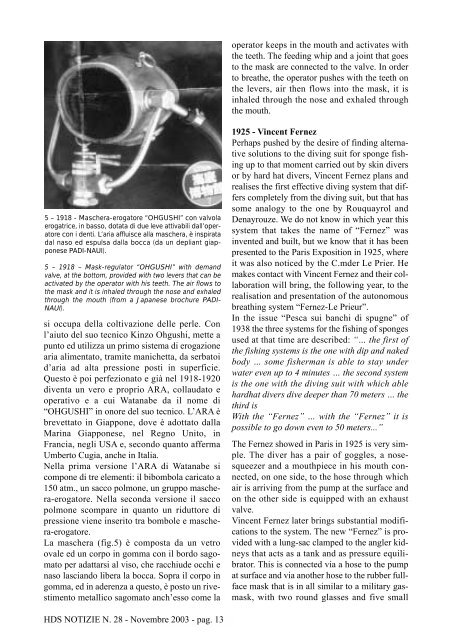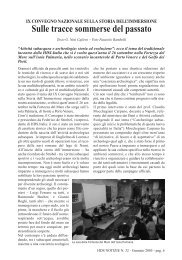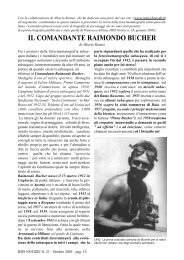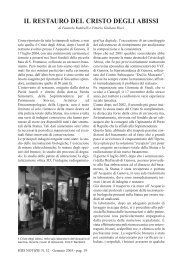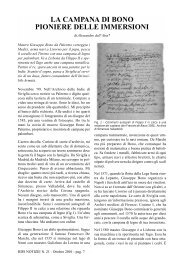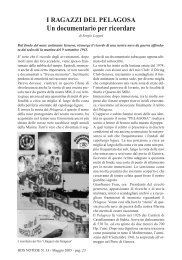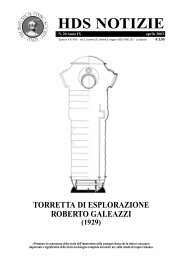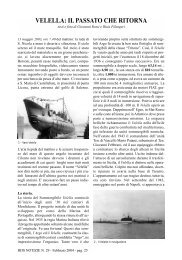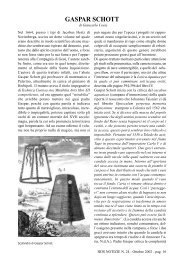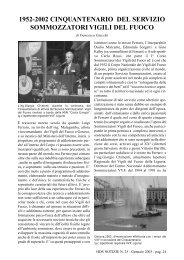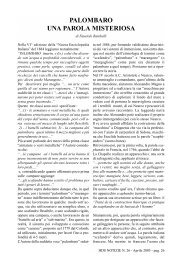Leggi l'intero numero - Historical Diving Society Italia
Leggi l'intero numero - Historical Diving Society Italia
Leggi l'intero numero - Historical Diving Society Italia
You also want an ePaper? Increase the reach of your titles
YUMPU automatically turns print PDFs into web optimized ePapers that Google loves.
5 – 1918 - Maschera-erogatore “OHGUSHI” con valvola<br />
erogatrice, in basso, dotata di due leve attivabili dall’operatore<br />
con i denti. L’aria affluisce alla maschera, è inspirata<br />
dal naso ed espulsa dalla bocca (da un depliant giapponese<br />
PADI-NAUI).<br />
5 – 1918 – Mask-regulator “OHGUSHI” with demand<br />
valve, at the bottom, provided with two levers that can be<br />
activated by the operator with his teeth. The air flows to<br />
the mask and it is inhaled through the nose and exhaled<br />
through the mouth (from a Japanese brochure PADI-<br />
NAUI).<br />
si occupa della coltivazione delle perle. Con<br />
l’aiuto del suo tecnico Kinzo Ohgushi, mette a<br />
punto ed utilizza un primo sistema di erogazione<br />
aria alimentato, tramite manichetta, da serbatoi<br />
d’aria ad alta pressione posti in superficie.<br />
Questo è poi perfezionato e già nel 1918-1920<br />
diventa un vero e proprio ARA, collaudato e<br />
operativo e a cui Watanabe da il nome di<br />
“OHGUSHI” in onore del suo tecnico. L’ARA è<br />
brevettato in Giappone, dove è adottato dalla<br />
Marina Giapponese, nel Regno Unito, in<br />
Francia, negli USA e, secondo quanto afferma<br />
Umberto Cugia, anche in <strong>Italia</strong>.<br />
Nella prima versione l’ARA di Watanabe si<br />
compone di tre elementi: il bibombola caricato a<br />
150 atm., un sacco polmone, un gruppo maschera-erogatore.<br />
Nella seconda versione il sacco<br />
polmone scompare in quanto un riduttore di<br />
pressione viene inserito tra bombole e maschera-erogatore.<br />
La maschera (fig.5) è composta da un vetro<br />
ovale ed un corpo in gomma con il bordo sagomato<br />
per adattarsi al viso, che racchiude occhi e<br />
naso lasciando libera la bocca. Sopra il corpo in<br />
gomma, ed in aderenza a questo, è posto un rivestimento<br />
metallico sagomato anch’esso come la<br />
HDS NOTIZIE N. 28 - Novembre 2003 - pag. 13<br />
operator keeps in the mouth and activates with<br />
the teeth. The feeding whip and a joint that goes<br />
to the mask are connected to the valve. In order<br />
to breathe, the operator pushes with the teeth on<br />
the levers, air then flows into the mask, it is<br />
inhaled through the nose and exhaled through<br />
the mouth.<br />
1925 - Vincent Fernez<br />
Perhaps pushed by the desire of finding alternative<br />
solutions to the diving suit for sponge fishing<br />
up to that moment carried out by skin divers<br />
or by hard hat divers, Vincent Fernez plans and<br />
realises the first effective diving system that differs<br />
completely from the diving suit, but that has<br />
some analogy to the one by Rouquayrol and<br />
Denayrouze. We do not know in which year this<br />
system that takes the name of “Fernez” was<br />
invented and built, but we know that it has been<br />
presented to the Paris Exposition in 1925, where<br />
it was also noticed by the C.mder Le Prier. He<br />
makes contact with Vincent Fernez and their collaboration<br />
will bring, the following year, to the<br />
realisation and presentation of the autonomous<br />
breathing system “Fernez-Le Prieur”.<br />
In the issue “Pesca sui banchi di spugne” of<br />
1938 the three systems for the fishing of sponges<br />
used at that time are described: “… the first of<br />
the fishing systems is the one with dip and naked<br />
body … some fisherman is able to stay under<br />
water even up to 4 minutes … the second system<br />
is the one with the diving suit with which able<br />
hardhat divers dive deeper than 70 meters … the<br />
third is<br />
With the “Fernez” … with the “Fernez” it is<br />
possible to go down even to 50 meters...”<br />
The Fernez showed in Paris in 1925 is very simple.<br />
The diver has a pair of goggles, a nosesqueezer<br />
and a mouthpiece in his mouth connected,<br />
on one side, to the hose through which<br />
air is arriving from the pump at the surface and<br />
on the other side is equipped with an exhaust<br />
valve.<br />
Vincent Fernez later brings substantial modifications<br />
to the system. The new “Fernez” is provided<br />
with a lung-sac clamped to the angler kidneys<br />
that acts as a tank and as pressure equilibrator.<br />
This is connected via a hose to the pump<br />
at surface and via another hose to the rubber fullface<br />
mask that is in all similar to a military gasmask,<br />
with two round glasses and five small


